PSY 351 Test #2 SDSU
5.0(1)
5.0(1)
Card Sorting
1/173
Earn XP
Description and Tags
Chapters 7-12. Based on Dr. Twenge's textbook & lectures.
Study Analytics
Name | Mastery | Learn | Test | Matching | Spaced |
|---|
No study sessions yet.
174 Terms
1
New cards
Goals
* specific outcomes people desire
* influenced by motives, which are driven by needs
* influenced by motives, which are driven by needs
2
New cards
Motives
* the psychological entities that drive us to behave in certain ways that will help us meet our goals
* driven by needs & influences goals
* driven by needs & influences goals
3
New cards
Needs
* something that is necessary to survive or thrive
* drive motives, which influence goals
* drive motives, which influence goals
4
New cards
Approach motivation
* anticipating rewards for success
* one of the two ways to react to a challenge
* motivated more by moving toward the goal
* one of the two ways to react to a challenge
* motivated more by moving toward the goal
5
New cards
Avoidance motivation
* worrying about the negative consequences of failure
* one of the two ways to react to a challenge
* motivated more by moving away from danger or failure
* one of the two ways to react to a challenge
* motivated more by moving away from danger or failure
6
New cards
Test and ink color study
* in one study, students took a cognitive performance test with their subject number written in either red, green, or black ink (randomly varied)
* red ink made people perform *worse* on the test
* red primed avoidance motivation b/c of its association with red pens and negative feedback and with red stop signs
* in Western cultures, red is strongly associated with avoidance
* red ink made people perform *worse* on the test
* red primed avoidance motivation b/c of its association with red pens and negative feedback and with red stop signs
* in Western cultures, red is strongly associated with avoidance
7
New cards
An example of how situation can affect whether approach or avoidance motivation is triggered
* people under threat tend to experience increased avoidance motivation while approach motivation doesn’t change
8
New cards
The focus of Maslow’s hierarchy of needs
* no life goals would matter if you didn’t have enough basic needs
9
New cards
Humanistic psychology
* a branch of psychology focused on the “whole person,” including free will, creativity, and human potential
* Maslow was a proponent of & theorized humans must fulfill their needs in a certain order
* Maslow was a proponent of & theorized humans must fulfill their needs in a certain order
10
New cards
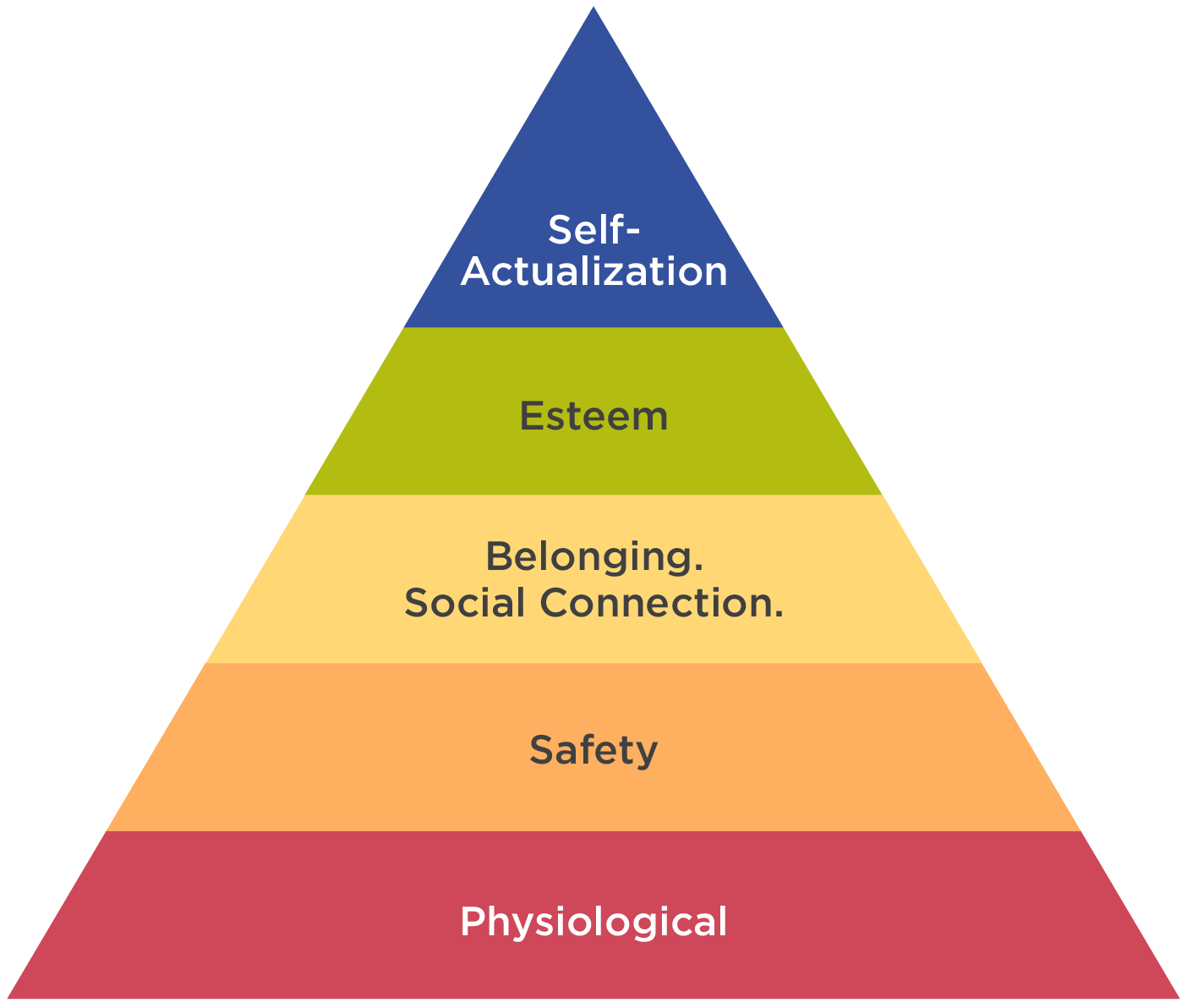
Basic physiological needs
* breathing, food, water, shelter, clothing, sleep, sex
* if you don’t get these, it’s tough to think of anything else
* if you don’t get these, it’s tough to think of anything else
11
New cards

Safety and security needs
* health, employment, property, social stability, resources
12
New cards
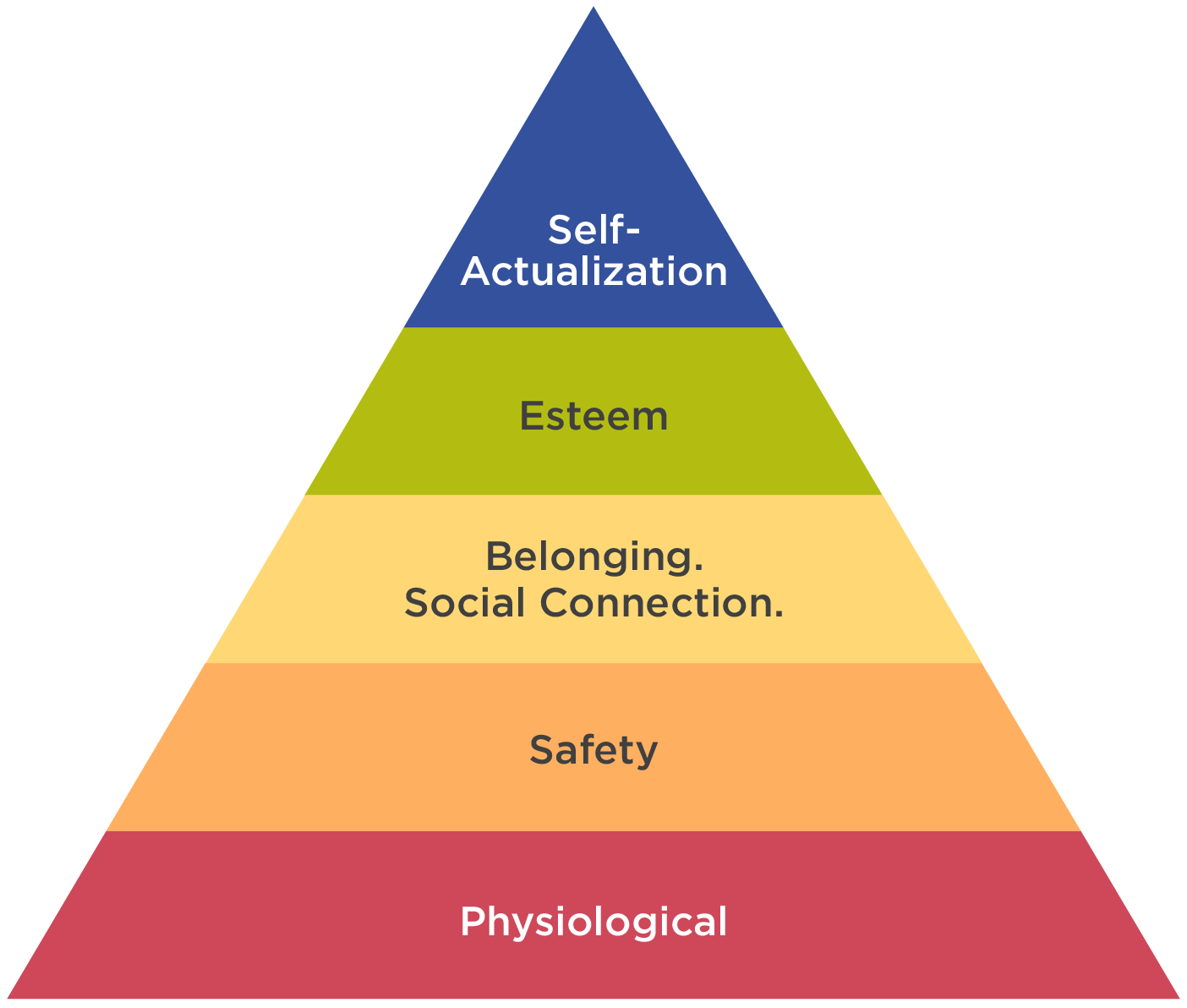
Love and belonging needs
* friendship, family, intimacy, a sense of connection
* a fundamental human motivation
* creates the motive to affiliate with others
* a fundamental human motivation
* creates the motive to affiliate with others
13
New cards
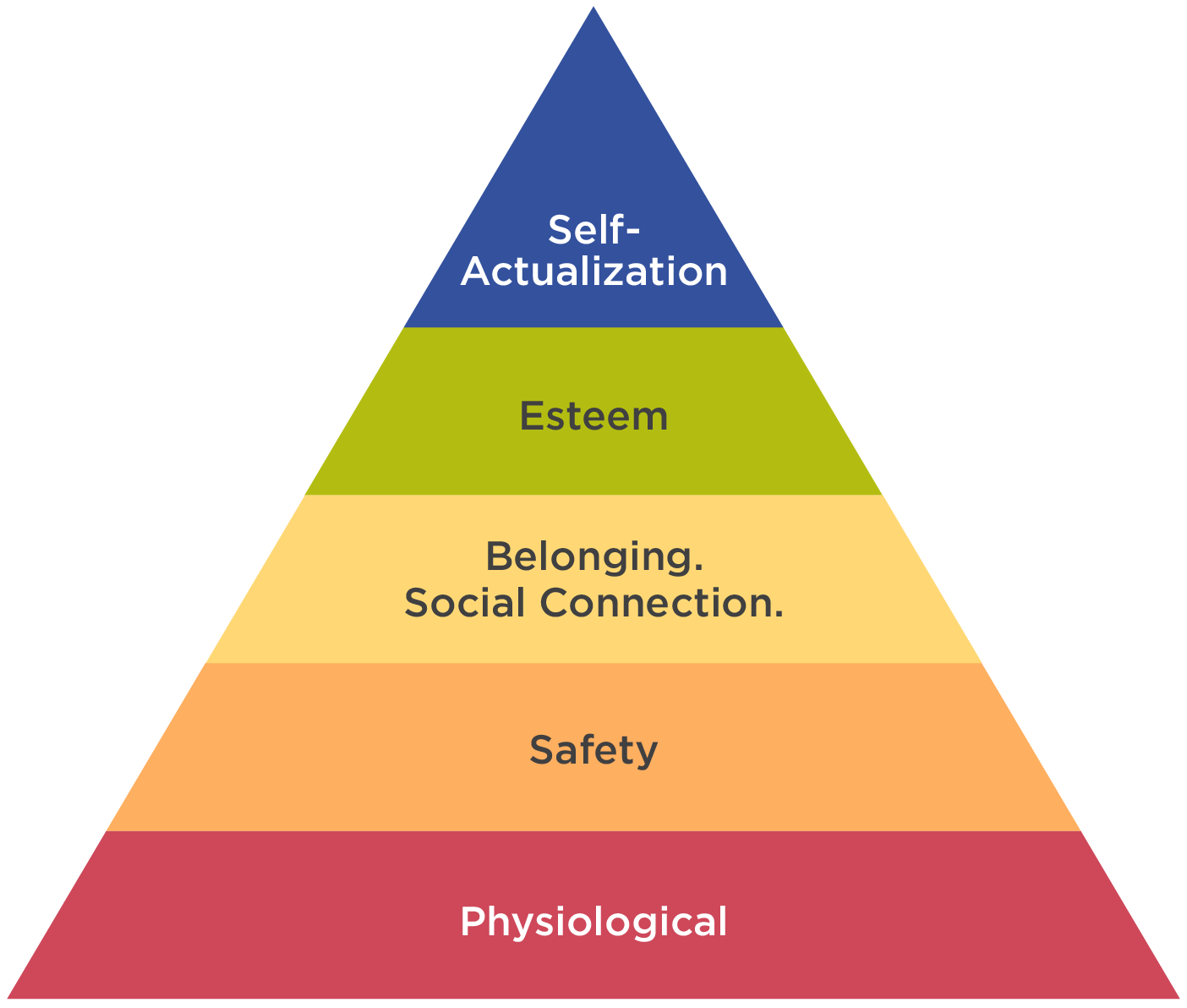
Self-esteem needs
* confidence, achievement, respect of others
* different from chapter 5
* Maslow believed this need is best when it’s grounded in actual achievement and behavior (i.e., “deserved”) rather than undeserved and gained through cheating or inflated praise
* different from chapter 5
* Maslow believed this need is best when it’s grounded in actual achievement and behavior (i.e., “deserved”) rather than undeserved and gained through cheating or inflated praise
14
New cards
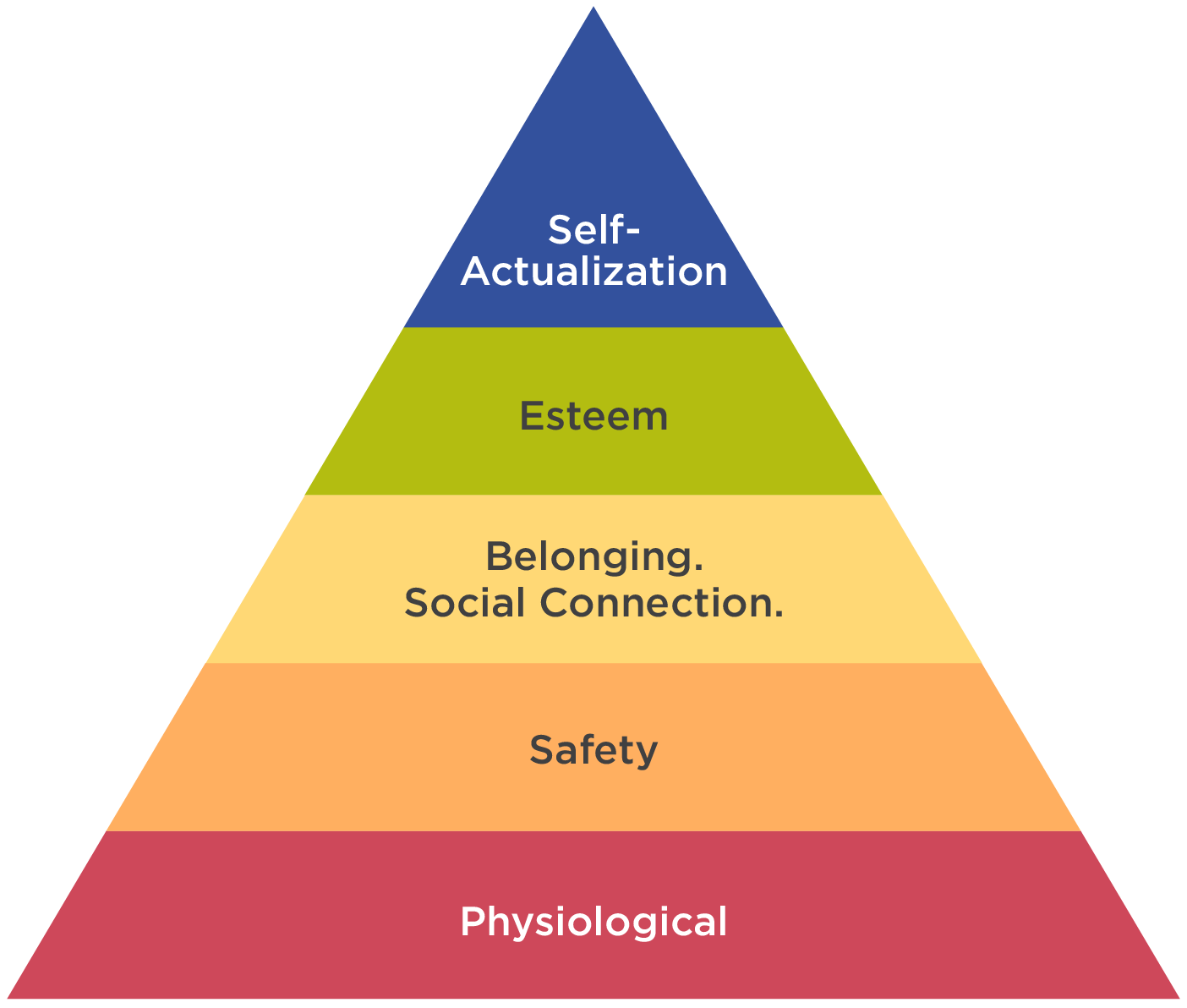
Self-actualization needs
* creativity, spontaneity, problem-solving, fulfilling potential, morality
* the need to actualize or “make actual” your unique talents and abilities
* attainment is rare
* the need to actualize or “make actual” your unique talents and abilities
* attainment is rare
15
New cards
Unconditional positive regard
* acceptance and love of someone’s whole self without conditions attached
* e.g., a parent liking or disliking their child’s actions but loving their child no matter what
* Carl Rogers, a humanistic psychologist, believed experiencing this would let people get close to self-actualization
* e.g., a parent liking or disliking their child’s actions but loving their child no matter what
* Carl Rogers, a humanistic psychologist, believed experiencing this would let people get close to self-actualization
16
New cards
Possible items measured in a self-actualization questionnaire
* time competence (living in the present moment)
* self-acceptance (including of weaknesses)
* capacity for intimate contact
* spontaneity
* inner-directedness (e.g., “I feel free to not do what others expect of me”)
* self-acceptance (including of weaknesses)
* capacity for intimate contact
* spontaneity
* inner-directedness (e.g., “I feel free to not do what others expect of me”)
17
New cards
Implicit motives
* unconscious motivations
* usually measured with projective tests
* often measured by having people tell stories in response to pictures
* older version in the Thematic Apperception Test (TAT)
* more recent version in the Picture Story Exercise (PSE)
* can be coded through analyzing speeches and stories
* often does *not* align with explicit motives of an individual
* usually measured with projective tests
* often measured by having people tell stories in response to pictures
* older version in the Thematic Apperception Test (TAT)
* more recent version in the Picture Story Exercise (PSE)
* can be coded through analyzing speeches and stories
* often does *not* align with explicit motives of an individual
18
New cards
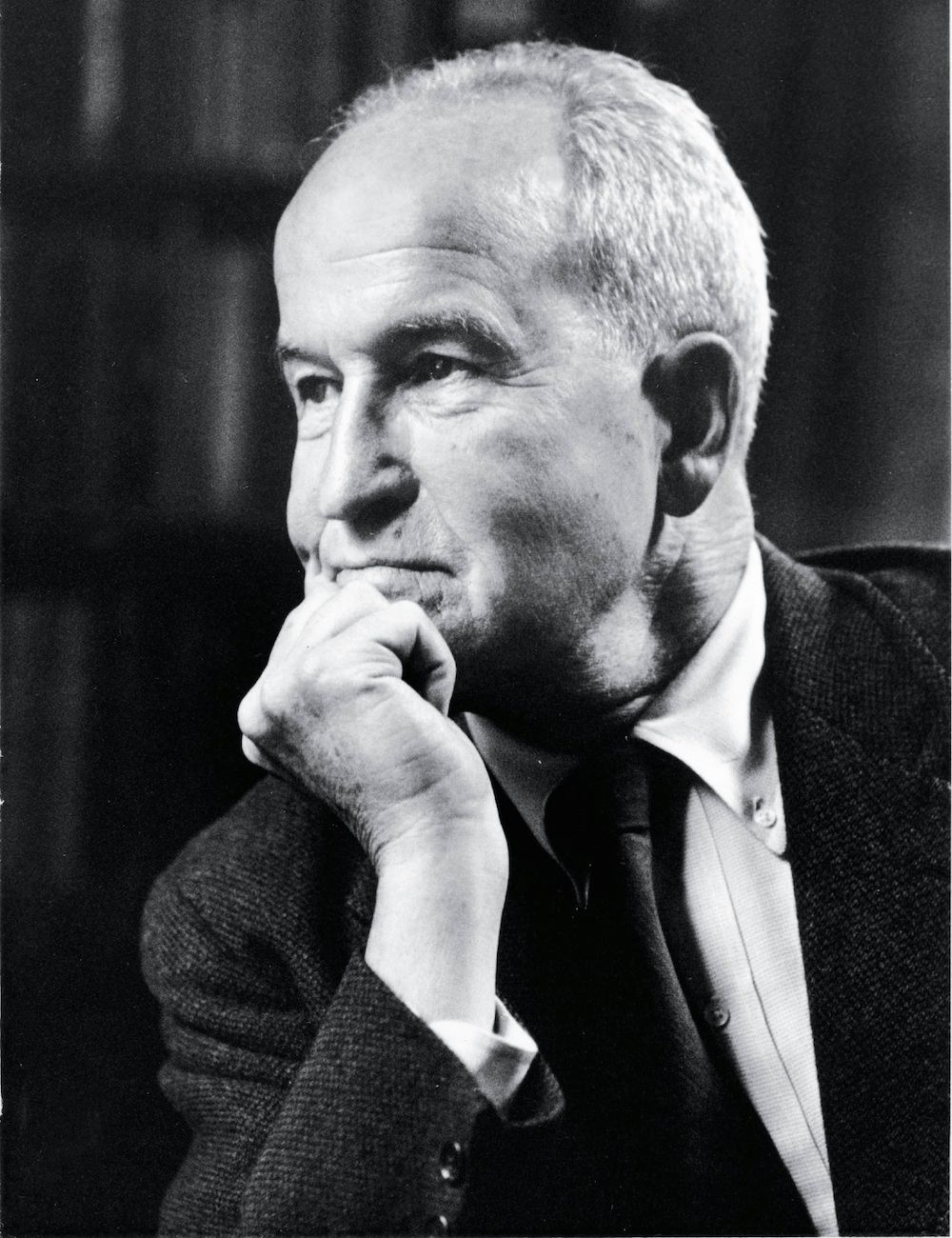
Henry Murray (1937)
* theorized that people are driven mostly by implicit motives
* according to his theory, you might not know the underlying motives for your own behavior
* came up with a list of 27 implicit motives (research has heavily focused on only 3)
* according to his theory, you might not know the underlying motives for your own behavior
* came up with a list of 27 implicit motives (research has heavily focused on only 3)
19
New cards
Projective measures
* indirect measures
* in theory, people project their motives onto the characters in a picture (such as in a TAT or PSE test)
* in theory, people project their motives onto the characters in a picture (such as in a TAT or PSE test)
20
New cards
3 major implicit motives
* power motive
* achievement motive
* affiliation motive
* achievement motive
* affiliation motive
21
New cards
Power motive
* wanting to have an impact on others
* people high in this motivation seek to influence others’ beliefs in subtle ways, such as appearing more competent and persuasive
* their parents generally allowed more aggressive or sexual behaviors
* men high in this motive prefer mates & friends lower in status than themselves
* originally called the need for power and abbreviated nPow
* overlap with Maslow’s need for self-esteem
* overlap with SDT’s need for autonomy
* people high in this motivation seek to influence others’ beliefs in subtle ways, such as appearing more competent and persuasive
* their parents generally allowed more aggressive or sexual behaviors
* men high in this motive prefer mates & friends lower in status than themselves
* originally called the need for power and abbreviated nPow
* overlap with Maslow’s need for self-esteem
* overlap with SDT’s need for autonomy
22
New cards
Achievement motive
* wanting to accomplish things, usually on one’s own and without help
* people high in this motivation prefer moderately challenging tasks (i.e., not so hard that they cannot be accomplished and not so easy that they don’t gain a feeling of accomplishment)
* originally called the need for achievement and abbreviated nAch
* overlap with Maslow’s need for self-esteem
* overlap with SDT’s need for competence
* people high in this motivation prefer moderately challenging tasks (i.e., not so hard that they cannot be accomplished and not so easy that they don’t gain a feeling of accomplishment)
* originally called the need for achievement and abbreviated nAch
* overlap with Maslow’s need for self-esteem
* overlap with SDT’s need for competence
23
New cards
Affiliation motive
* being motivated by one’s relationships with others
* people high in this motivation are better able to make concessions in negotiations and end conflicts
* women on average are higher in this motive than men
* it was a married couple’s (the Lovings) court case that pushed to legalize interracial marriage
* originally called the need for affiliation and abbreviated nAff
* similar to Maslow’s need for belonging
* overlap with SDT’s need for relatedness
* people high in this motivation are better able to make concessions in negotiations and end conflicts
* women on average are higher in this motive than men
* it was a married couple’s (the Lovings) court case that pushed to legalize interracial marriage
* originally called the need for affiliation and abbreviated nAff
* similar to Maslow’s need for belonging
* overlap with SDT’s need for relatedness
24
New cards
Presidents & implicit motives
* psychologist David Winter coded implicit motives in every U.S. president’s inaugural speech
* high on nAff: both Bushes, Kennedy, Nixon
* high on nAch: Trump, Carter, Clinton
* high on nPow: Trump, Kennedy, Truman, W. Bush, Obama
* high on nAff: both Bushes, Kennedy, Nixon
* high on nAch: Trump, Carter, Clinton
* high on nPow: Trump, Kennedy, Truman, W. Bush, Obama
25
New cards
Explicit motives
* conscious motivations
* usually measured by self-report
* often does *not* align with implicit motives of an individual
* usually measured by self-report
* often does *not* align with implicit motives of an individual
26
New cards
Differences in implicit and explicit motives
* implicit motives are more likely to predict performance
* influenced by both conscious and unconscious factors
* explicit motives are more likely to predict choices and judgments
* primarily conscious
* influenced by both conscious and unconscious factors
* explicit motives are more likely to predict choices and judgments
* primarily conscious
27
New cards
Self-determination theory (SDT)
* argues that three needs (autonomy, competence, and relatedness) can explain much of human behavior
28
New cards
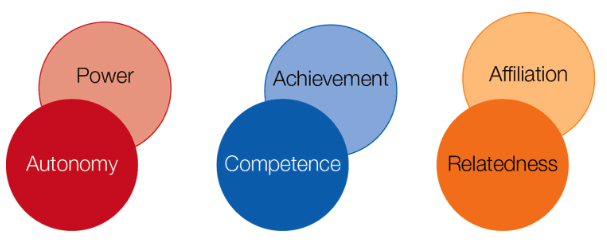
Differences in self-determination theory and Murray’s three primary implicit motives
* overlap: power & autonomy, achievement & competence, affiliation & relatedness
* SDT focuses on explicit motives (those people consciously report)
* considers these three needs as essential to human functioning
* Murray’s theory focuses on implicit motives (those which are not always conscious)
* most research here focuses on variations among people
* SDT focuses on explicit motives (those people consciously report)
* considers these three needs as essential to human functioning
* Murray’s theory focuses on implicit motives (those which are not always conscious)
* most research here focuses on variations among people
29
New cards
Autonomy
* having control over your actions and life
* overlap with Murray’s implicit motive of power
* overlap with Murray’s implicit motive of power
30
New cards
Competence
* being able to use your skills effectively and learn new ones
* overlap with Murray’s implicit motive of achievement
* overlap with Murray’s implicit motive of achievement
31
New cards
Relatedness
* feeling connected to others, both personally and in your community
* overlap with Murray’s implicit motive of affiliation
* overlap with Murray’s implicit motive of affiliation
32
New cards
SDT & culture
* a study measuring the 3 needs in eight countries found that they predicted meaning in life and personal growth about equally well in all eight countries
* some cultures are better than others at satisfying these fundamental needs
* if a culture or its economic system does not do a good job satisfying one or more of the needs, the culture might undergo a change or even a revolution
* some cultures are better than others at satisfying these fundamental needs
* if a culture or its economic system does not do a good job satisfying one or more of the needs, the culture might undergo a change or even a revolution
33
New cards
Extrinsic goals
* financial success, popularity or fame, and image or physical attractiveness
* popular culture in the United States more often promotes these goals
* people who focus on these are more likely to suffer from anxiety, depression, headaches, and stomachaches & are less likely to be happy
* popular culture in the United States more often promotes these goals
* people who focus on these are more likely to suffer from anxiety, depression, headaches, and stomachaches & are less likely to be happy
34
New cards
Monopoly money study
* one study with game currency had people handle money
* these people thought about growing up rich
* these people were less likely to help others & more likely to want to work alone
* these people thought about growing up rich
* these people were less likely to help others & more likely to want to work alone
35
New cards
Intrinsic goals
* personal growth, affiliation, and community feeling
* things we know we “should” value
* valuing these goals benefits the individual, cultures, nations, and the world as a whole
* things we know we “should” value
* valuing these goals benefits the individual, cultures, nations, and the world as a whole
36
New cards
What Murray’s implicit motives, SDT’s explicit motives, and theories of extrinsic vs intrinsic goals have in common
* all try to understand individual differences in what people value and how it affects their actions
37
New cards
Dilemma with intrinsic goals
* in general, focusing on one type of goal makes it more difficult to focus on a different type
* e.g., achievement-focused people might not be able to focus as much on caring for others
* question of whether or not we can we “have it all”
* e.g., achievement-focused people might not be able to focus as much on caring for others
* question of whether or not we can we “have it all”
38
New cards
Extrinsic motivation
* motivation outside the self
* e.g., money or praise from others
* sound good but can actually decrease intrinsic motivation to do well and their effects disappear when they are removed
* e.g., your professor asks you to read the textbook in return for a letter of recommendation so you do; you are *less* likely to want to read it in your own time afterward
* e.g., money or praise from others
* sound good but can actually decrease intrinsic motivation to do well and their effects disappear when they are removed
* e.g., your professor asks you to read the textbook in return for a letter of recommendation so you do; you are *less* likely to want to read it in your own time afterward
39
New cards
Intrinsic motivation
* motivation inside the self
* e.g., taking joy in an activity
* overall, the belief that ability is malleable (e.g., “I can get better if I work hard”) leads to greater motivation and better performance than the belief that ability is fixed (e.g., “I’m either smart or I’m not”)
* e.g., taking joy in an activity
* overall, the belief that ability is malleable (e.g., “I can get better if I work hard”) leads to greater motivation and better performance than the belief that ability is fixed (e.g., “I’m either smart or I’m not”)
40
New cards
Preschoolers, drawing, and certificate experiment
* in one study, preschoolers who like to draw were told they could earn a certificate with a large gold star & a ribbon
* other children drew but either didn’t get an award or got one unexpectedly
* a week later, those who were expectedly rewarded spent only half as much time drawing than those who didn’t get an award or unexpectedly got one
* other children drew but either didn’t get an award or got one unexpectedly
* a week later, those who were expectedly rewarded spent only half as much time drawing than those who didn’t get an award or unexpectedly got one
41
New cards
Positive psychology
* an area of psychology focused on what can make our lives better and what might make us happier
42
New cards
Mindfulness
* being aware of your thoughts and perceptions without clinging to them or judging whether they are good or bad
* “the case where a monk remains focused on the body in and of itself--ardent, alert, and mindful--putting aside greed and distress with reference to the world” (*Satipatthana Sutta*, 2008)
* people who are low in neuroticism and high in conscientiousness tend to be better at practicing this
* practice has been shown to help treat anxiety disorders
* the most common way to practice this is with meditation
* can lead to peak experiences
* “the case where a monk remains focused on the body in and of itself--ardent, alert, and mindful--putting aside greed and distress with reference to the world” (*Satipatthana Sutta*, 2008)
* people who are low in neuroticism and high in conscientiousness tend to be better at practicing this
* practice has been shown to help treat anxiety disorders
* the most common way to practice this is with meditation
* can lead to peak experiences
43
New cards
Peak experiences
* times when people can transcend themselves and feel one with the world
* often result in a flow state
* often result in a flow state
44
New cards
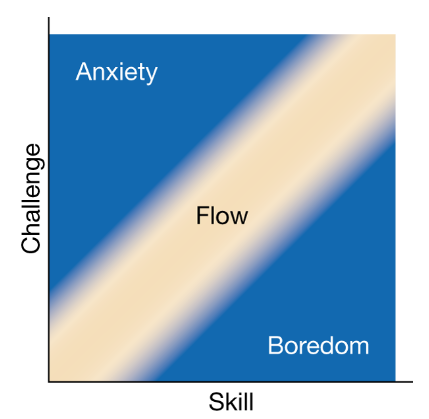
Flow state
* the smooth passage of time that occurs during a peak experience, when you are completely immersed in an activity in the present moment
* Csikszentmihalyi (1996) identified a “flow channel” between anxiety (when something is too difficult) and boredom (when something is too easy)
* Csikszentmihalyi (1996) identified a “flow channel” between anxiety (when something is too difficult) and boredom (when something is too easy)
45
New cards
Meaning in life
* having a purpose and putting time and energy into attaining important goals
* can come from religion, personal relationships, behaving in a way consistent with your beliefs, self-improvement
* people who find their lives meaningful are happier, and happier people find more meaning in life
* can come from religion, personal relationships, behaving in a way consistent with your beliefs, self-improvement
* people who find their lives meaningful are happier, and happier people find more meaning in life
46
New cards
Behaviorism
* a branch of psychology that focuses on (relatively) simple explanations for outward behavior and is unconcerned with the inner workings of the mind
* people do what they are rewarded for and avoid doing what they are punished for
* central to environmental effects on personality
* direct contrast to psychoanalytic theories
* the basis for programs to improve child behavior, treat addiction, and help people sleep better
* people do what they are rewarded for and avoid doing what they are punished for
* central to environmental effects on personality
* direct contrast to psychoanalytic theories
* the basis for programs to improve child behavior, treat addiction, and help people sleep better
47
New cards
Social learning
* learning to behave from watching other people’s behavior
48
New cards
The 2 Big Five traits shaped more by behavior than others
* agreeableness & conscientiousness
49
New cards
Operant conditioning
* shaping behavior (your own, someone else’s, and/or an animal’s) through rewards and punishments
* most associated with B.F. Skinner
* most associated with B.F. Skinner
50
New cards
4 ways of modifying behavior
* positive reinforcement
* negative reinforcement
* positive punishment
* negative punishment
* negative reinforcement
* positive punishment
* negative punishment
51
New cards
Positive reinforcement
* rewards or incentives for good behavior
* often the most effective way to shape behavior of the four ways to modify behavior
* Skinner’s experiments with animals relied on this type
* positive means the addition of something rather than something being “good”
* often the most effective way to shape behavior of the four ways to modify behavior
* Skinner’s experiments with animals relied on this type
* positive means the addition of something rather than something being “good”
52
New cards
Shaping
* gradual training that rewards behavior progressively closer to the desired one
53
New cards
Negative reinforcement
* rewards desired behavior by taking away something aversive
* e.g., your car stops beeping at you after you put on your seatbelt
* least common way to shape behavior of the four ways to modify behavior
* negative means the removal of something rather than something being “bad”
* e.g., your car stops beeping at you after you put on your seatbelt
* least common way to shape behavior of the four ways to modify behavior
* negative means the removal of something rather than something being “bad”
54
New cards
Positive punishment
* administering something aversive after misbehavior
* what people usually mean when they refer to *punishment*
* punishment, especially physical, changes behavior only temporarily and can cause children to become more aggressive, making it not very effective
* positive means the addition of something rather than something being “good”
* what people usually mean when they refer to *punishment*
* punishment, especially physical, changes behavior only temporarily and can cause children to become more aggressive, making it not very effective
* positive means the addition of something rather than something being “good”
55
New cards
Natural consequences
* punishments enacted naturally as a consequence of the negative behavior
* e.g., a 4-year-old purposefully dumps her milk on the kitchen floor and so must help clean it up
* e.g., a 4-year-old purposefully dumps her milk on the kitchen floor and so must help clean it up
56
New cards
Negative punishment
* stopping bad behavior by taking away something good
* also known as a *time-out*
* negative means the removal of something rather than something being “bad”
* also known as a *time-out*
* negative means the removal of something rather than something being “bad”
57
New cards
Thorndike’s experiment on cats
* Edward Thorndike's research confining cats to puzzle boxes was a combination of both negative and positive reinforcement
* negative reinforcement: the cat presses a lever (or pulls a string) and is freed from the box
* positive reinforcement: the cat presses a lever (or pulls a string), leaves the box, and is rewarded with food
* negative reinforcement: the cat presses a lever (or pulls a string) and is freed from the box
* positive reinforcement: the cat presses a lever (or pulls a string), leaves the box, and is rewarded with food
58
New cards
Reinforcement schedule
* giving out rewards for good behavior at certain intervals
59
New cards
Continuous reinforcement schedule
* always giving out a reward for good behavior
* e.g., giving your partner a kiss every time they take out the trash
* e.g., giving your partner a kiss every time they take out the trash
60
New cards
Partial reinforcement schedules
* only sometimes giving out a reward for good behavior
* the four types:
* fixed-ratio reinforcement
* variable-ratio reinforcement
* fixed-interval reinforcement
* variable-ratio reinforcement
* the four types:
* fixed-ratio reinforcement
* variable-ratio reinforcement
* fixed-interval reinforcement
* variable-ratio reinforcement
61
New cards
Fixed-ratio reinforcement
* giving a reward after a certain number of behaviors
* e.g., giving your partner a kiss only after they’ve taken out the trash twice
* e.g., giving your partner a kiss only after they’ve taken out the trash twice
62
New cards
Variable-ratio reinforcement
* giving out a reward after a random number of behaviors
* e.g., giving your partner a kiss after an unpredictable number of good behaviors
* usually lead to the greatest increase in the desired behavior out of the four partial reinforcement schedules
* e.g., giving your partner a kiss after an unpredictable number of good behaviors
* usually lead to the greatest increase in the desired behavior out of the four partial reinforcement schedules
63
New cards
Fixed-interval reinforcement
* giving out a reward after a certain amount of time has passed
* e.g., giving your partner a kiss every three days
* e.g., giving your partner a kiss every three days
64
New cards
Variable-interval reinforcement
* giving out a reward after a random amount of time has passed
* e.g., giving your partner a kiss randomly at intervals of one to five days
* e.g., giving your partner a kiss randomly at intervals of one to five days
65
New cards
Socialization
* how children learn to become mature members of society
* also known as *acculturation*
* different cultures and different families have different standards for this (e.g., arguing between members acceptable for some)
* also known as *acculturation*
* different cultures and different families have different standards for this (e.g., arguing between members acceptable for some)
66
New cards
Bobo doll experiment
* preschool children watched an adult woman repeatedly punch a large plastic toy that bounces back when hit
* three groups: children who saw the woman get punished afterward, children who saw her rewarded, and children who saw no consequences either way
* children who saw her punished were less likely to copy the woman’s actions than either of the other two groups
* three groups: children who saw the woman get punished afterward, children who saw her rewarded, and children who saw no consequences either way
* children who saw her punished were less likely to copy the woman’s actions than either of the other two groups
67
New cards

Reciprocal determinism
* Bandura’s theory that a person’s behavior causes the environment alongside the environment causing behavior
68
New cards

Albert Bandura
* reciprocal determinism
* argues that personality arises from the environment’s effect on behavior, behavior’s effect on the environment, and the way people process their experiences
* e.g., when Bandura’s parents immigrated to Canada, their personalities helped dictate this choice (a behavior), and their behaviors (living far from home and clearing land) may have shaped their personalities (perhaps making them more conscientious)
* argues that personality arises from the environment’s effect on behavior, behavior’s effect on the environment, and the way people process their experiences
* e.g., when Bandura’s parents immigrated to Canada, their personalities helped dictate this choice (a behavior), and their behaviors (living far from home and clearing land) may have shaped their personalities (perhaps making them more conscientious)
69
New cards
Behavior modification
* practical application of operant conditioning to improve behavior
* also known as *behavior mod* or *b-mod*
* can use b-mod on others and self
* also known as *behavior mod* or *b-mod*
* can use b-mod on others and self
70
New cards
Token economy
* a program in which good behavior is rewarded with tokens that can be exchanged for privileges
71
New cards
Watson and Skinner on b-mod
* John Watson and B.F. Skinner believed that they could use the environment to shape children into any type of person they chose
* this vision probably not realistic b/c personality is also determined by genetics, not just the environment (like we learned in chap 4)
* this vision probably not realistic b/c personality is also determined by genetics, not just the environment (like we learned in chap 4)
72
New cards
Expectancies
* what someone expects to happen, based on past experiences of what was rewarding
* the decisions people think about and make every day based on past experiences
* the decisions people think about and make every day based on past experiences
73
New cards
Reinforcement value
* how enticing a particular reward is
* e.g., value of meeting new people is less when in a relationship than if you are single and looking
* our personalities and motivations also influence what rewards we value the most
* e.g., value of meeting new people is less when in a relationship than if you are single and looking
* our personalities and motivations also influence what rewards we value the most
74
New cards
Generalized expectancies
* beliefs about how often actions lead to rewards versus punishment
75
New cards
External locus of control
* believing that events are more a matter of luck and the arbitrary decisions of powerful people
* people with this locus are more likely to be anxious and depressed
* linked to failure
* people with this locus are more likely to be anxious and depressed
* linked to failure
76
New cards
Internal locus of control
* believing that your actions have an effect on events
* #1 predictor of school achievement among racial minority children
* i.e., believing that studying matters leads to more studying, which leads to better grades
* #1 predictor of school achievement among racial minority children
* i.e., believing that studying matters leads to more studying, which leads to better grades
77
New cards
Pavlov’s dog
* Ivan Pavlov was originally studying digestion and wanted to find out how much dogs salivated when fed
* he found that they began salivating *before* eating and sometimes even before seeing the food b/c they began to associate the person who brought the food (or the bell) with the food
* he found that they began salivating *before* eating and sometimes even before seeing the food b/c they began to associate the person who brought the food (or the bell) with the food
78
New cards
Classical conditioning
* associating two things not normally associated with each other
* associations can occur in everyday life after traumatic or unpleasant experiences
* associations can occur in everyday life after traumatic or unpleasant experiences
79
New cards
Unconditioned stimulus (UCS)
* the stimulus normally producing the unconditioned response
* e.g., food producing salivation
* e.g., food producing salivation
80
New cards
Unconditioned response (UCR)
* the response normally produced by the unconditioned stimulus
* e.g., salivation being produced by food
* e.g., salivation being produced by food
81
New cards
Conditioned stimulus (CS)
* the stimulus that produces the conditioned response after classical conditioning
* e.g., a bell causing dogs to salivate
* e.g., a bell causing dogs to salivate
82
New cards
Conditioned response (CR)
* the response produced by the conditioned stimulus after classical conditioning
* e.g., salivation following the sound of the bell
* e.g., salivation following the sound of the bell
83
New cards
Little Albert
* John Watson and Rosalie Rayner’s experiment that had a child named Albert conditioned to fear a white rat
* at first, there was no fear; then, Watson & Rayner would make a loud, unpleasant noise every time Albert saw the rat (making him cry)
* Albert’s fear transferred to other small, white things such as rabbits, dogs, and fur coats (generalized)
* he was not deconditioned
* at first, there was no fear; then, Watson & Rayner would make a loud, unpleasant noise every time Albert saw the rat (making him cry)
* Albert’s fear transferred to other small, white things such as rabbits, dogs, and fur coats (generalized)
* he was not deconditioned
84
New cards
Generalized
* when a conditioned response is elicited in response to things similar to the conditioned stimulus
85
New cards
Deconditioning
* reversing conditioning to eliminate the conditioned response
* this process may begin with discrimination and ultimately end in extinction
* this process may begin with discrimination and ultimately end in extinction
86
New cards
Discrimination
* narrowing the conditions that produce the conditioned response (i.e., making the fear less broad)
87
New cards
Extinction
* elimination of the conditioned response
88
New cards
Spontaneous recovery
* relearning a conditioned response
89
New cards
Habituation
* getting used to something in the environment and not responding as strongly anymore
* e.g., you don’t think about the feeling of clothes against your skin very often
* useful for studying infants b/c they will look at something new longer than something familiar
* e.g., you don’t think about the feeling of clothes against your skin very often
* useful for studying infants b/c they will look at something new longer than something familiar
90
New cards
Sleep & classical conditioning
* make sure you associate your bed with relaxation and sleep (as opposed to doing work on a laptop or fighting with your partner over the phone)
* this is especially helpful for people who score high in neuroticism, as they are more prone to insomnia
* this is especially helpful for people who score high in neuroticism, as they are more prone to insomnia
91
New cards
Phobia
* an intense fear of a specific thing
92
New cards
Systematic desensitization
* a treatment for phobias that attempts to reduce fear in many small steps by associating the feared thing with calmness
* e.g., imagining a lesser/fake version of the fear, then imaging the real fear, then imagining doing/interacting with the fear, then seeing a fake version of the fear in person, then seeing the real fear from a distance in person, then gradually getting closer until you touch/do the fear
* e.g., imagining a lesser/fake version of the fear, then imaging the real fear, then imagining doing/interacting with the fear, then seeing a fake version of the fear in person, then seeing the real fear from a distance in person, then gradually getting closer until you touch/do the fear
93
New cards
Progressive relaxation
* learning how to systematically relax your body so your mind calms
* a part of the systematic desensitization process
* a part of the systematic desensitization process
94
New cards
Flooding
* confronting your worst fear head-on, all at once
* more acutely upsetting than the other treatment but completed much quicker
* more acutely upsetting than the other treatment but completed much quicker
95
New cards
Cross-sectional study
* data is collected at one time that compares people of different ages
* the downside to this compared to a longitudinal study is that the different ages groups are also different people
* the downside to this compared to a longitudinal study is that the different ages groups are also different people
96
New cards
Temperament
* genetically based behavioral tendencies seen in young children
* used to study children’s personality b/c they’re too young to answer questions about their own personality
* of the Big Five, extraversion, conscientiousness, and neuroticism overlap the most with this (i.e., they’re the easiest to describe & observe)
* children’s personality traits begin to more clearly resemble the Big Five structure common in adults by age 16
* these factors in childhood are reasonably good at predicting personality during early young adulthood
* used to study children’s personality b/c they’re too young to answer questions about their own personality
* of the Big Five, extraversion, conscientiousness, and neuroticism overlap the most with this (i.e., they’re the easiest to describe & observe)
* children’s personality traits begin to more clearly resemble the Big Five structure common in adults by age 16
* these factors in childhood are reasonably good at predicting personality during early young adulthood
97
New cards

Self-esteem over time
* three longitudinal and two cross-sectional studies find that both boys’ and girls’ openness to experience increases between age 11 and 18
* self-esteem is moderate during elementary school, dips during the early teen years, and then increases during high school and young adulthood
* girls’ self-esteem doesn’t increase as fast as boys’ does between middle school and high school
* a 20-year longitudinal study of 104 people found that men’s self-esteem was significantly higher than women’s at age 23
* self-esteem is moderate during elementary school, dips during the early teen years, and then increases during high school and young adulthood
* girls’ self-esteem doesn’t increase as fast as boys’ does between middle school and high school
* a 20-year longitudinal study of 104 people found that men’s self-esteem was significantly higher than women’s at age 23
98
New cards
Birth order on personality
* has only a small effect (4% of differences in personality at most)
* youngest children have slightly higher agreeableness & are more open to experience
* oldest children have slightly higher extraversion and self-confidence
* very little evidence that middleborns differ from their siblings
* research does *not* back up the claim that only children are selfish and poorly adjusted
* a meta-analysis found no differences between them & those with siblings on leadership, maturity, cooperativeness, autonomy, self-control, anxiety, popularity with peers, or extraversion
* youngest children have slightly higher agreeableness & are more open to experience
* oldest children have slightly higher extraversion and self-confidence
* very little evidence that middleborns differ from their siblings
* research does *not* back up the claim that only children are selfish and poorly adjusted
* a meta-analysis found no differences between them & those with siblings on leadership, maturity, cooperativeness, autonomy, self-control, anxiety, popularity with peers, or extraversion
99
New cards
Personality over long periods of time
* on average, people become less neurotic and more conscientious as they age from young adulthood to middle adulthood
* many studies conclude that much of the change in adult personality is complete by age 30
* personality develops and changes the most during childhood & becomes most stable when people are in their 40s & 50s
* of the Big Five, agreeableness is the only trait that continues to *increase* after the age of 50
* the age/generation difference found in studies looking at narcissism is about twice as large as the generational difference in narcissism
* suggests at least some differences in narcissism are due to age
* many studies conclude that much of the change in adult personality is complete by age 30
* personality develops and changes the most during childhood & becomes most stable when people are in their 40s & 50s
* of the Big Five, agreeableness is the only trait that continues to *increase* after the age of 50
* the age/generation difference found in studies looking at narcissism is about twice as large as the generational difference in narcissism
* suggests at least some differences in narcissism are due to age
100
New cards
Mean-level changes
* shifts in a population’s average scores with age